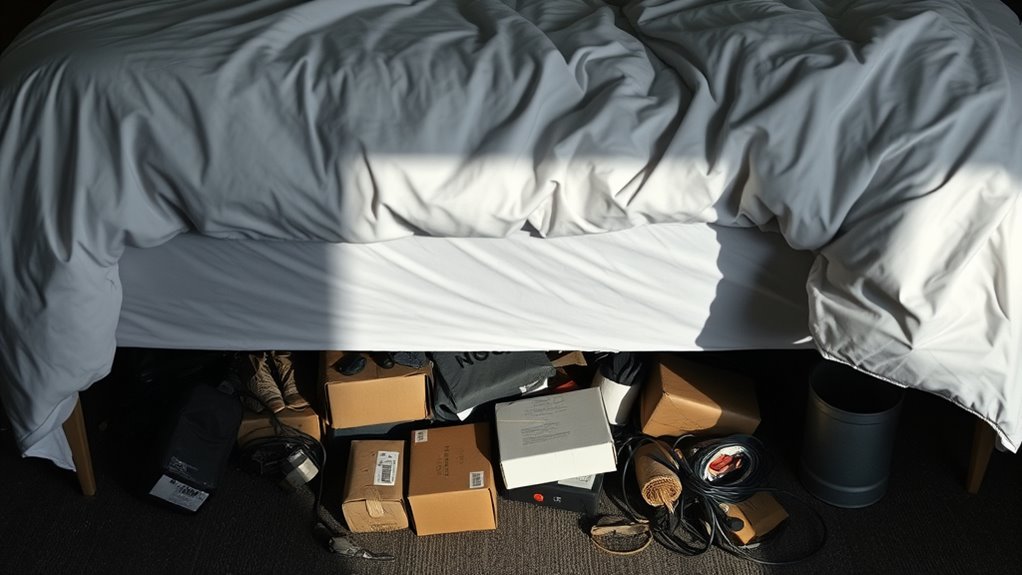Under-bed storage can seem helpful, but it often hides problems that disrupt your sleep. Dust, allergens, and mold can build up underneath, triggering allergies or respiratory issues. Clutter attracts pests like dust mites, spiders, and rodents, which cause bites and allergies. Materials stored there may emit harmful chemicals, and moisture can promote mold growth. These issues create a chaotic environment that increases stress and hampers relaxation. Keep going to discover simple ways to transform your sleep space and improve your well-being.
Key Takeaways
- Clutter under the bed can increase stress and anxiety, disrupting relaxation and sleep quality.
- Hidden dust, allergens, and mold beneath the bed can cause allergies and respiratory issues affecting sleep.
- Moisture buildup under the bed promotes mold growth, which can harm respiratory health and cause discomfort.
- Pests attracted by clutter, such as dust mites and rodents, can disturb sleep and pose health risks.
- Regular cleaning, proper ventilation, and reducing clutter improve sleep environment and overall well-being.
How Under-Bed Clutter Disrupts Your Sleep Environment
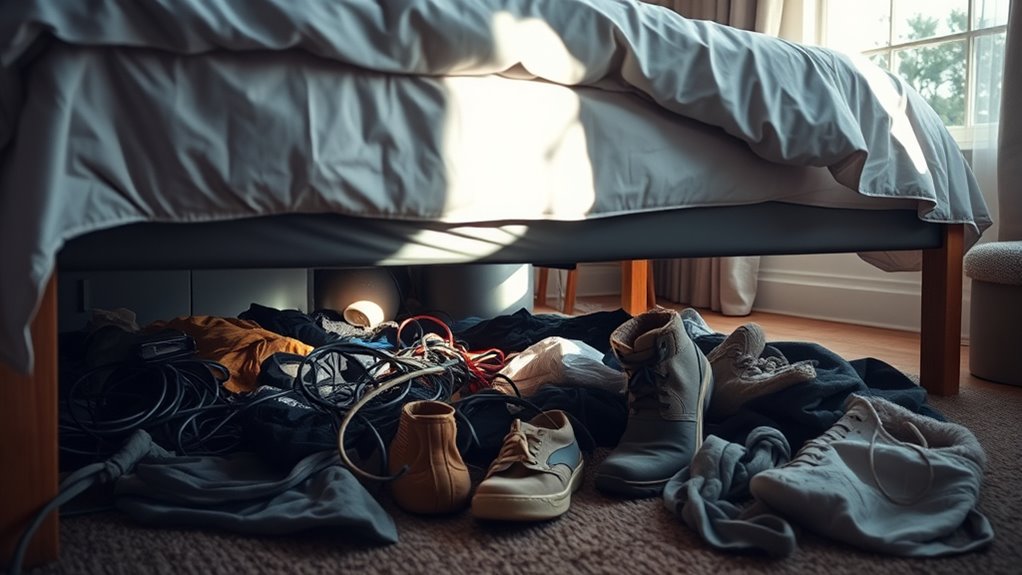
Have you ever noticed how clutter under your bed can quietly sabotage your sleep? When your sleeping area is filled with boxes, clothes, or random items, it creates a chaotic environment that can increase stress and make you feel anxious. This mess can also make your room look smaller and less inviting, affecting your ability to relax. The constant visual reminder of clutter can keep your mind active, preventing you from winding down easily. Additionally, the clutter might trap dust and allergens, even if you don’t see it, which can disturb your sleep. Proper ventilation can help reduce dust accumulation and improve air quality in your sleeping space. Incorporating natural elements like fresh flowers or woven baskets into your decor can create a more calming atmosphere. Clearing out under your bed can restore a sense of order and calm, helping your mind relax and your sleep improve. A tidy space encourages a peaceful atmosphere essential for restful sleep. Maintaining a clutter-free environment aligns with creating a relaxing farmhouse bedroom ambience, promoting better sleep quality. Regularly inspecting and cleaning the area can further prevent dust buildup and maintain a healthy sleeping environment. Moreover, understanding how energetic alignment influences your surroundings can motivate you to create a more harmonious space conducive to restful sleep.
The Connection Between Dust, Allergens, and Sleep Quality
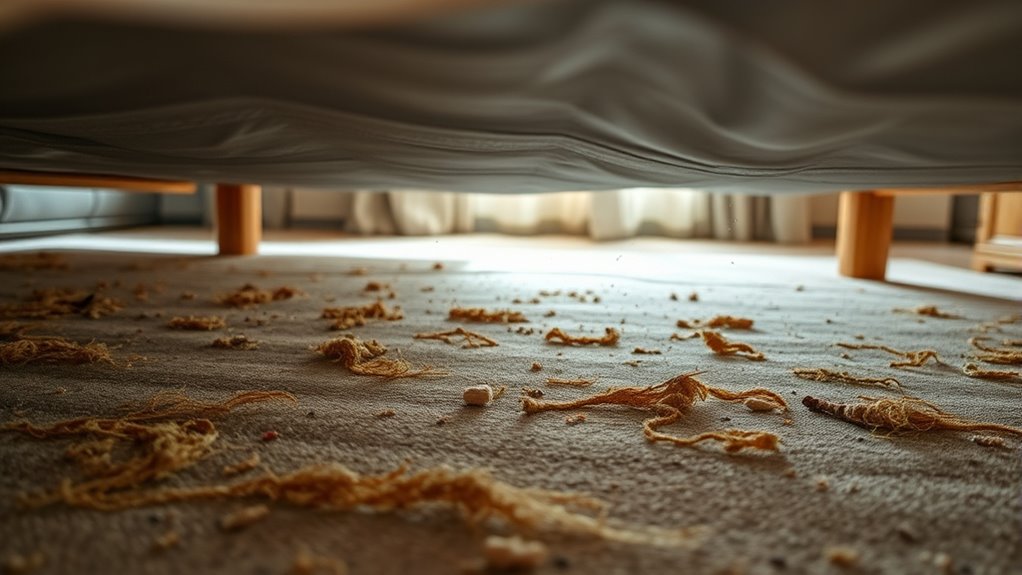
Since dust and allergens tend to accumulate under your bed, they can substantially affect your sleep quality without you even realizing it. These hidden irritants can trigger allergies, cause congestion, and disrupt your rest. To understand their impact, consider this: Patterns of behavior may cause allergens to build up more rapidly in certain environments. Regular cleaning and proper ventilation reduce these allergens, helping you breathe easier and sleep better. Air quality management is especially important for minimizing mold spores and other airborne irritants. Additionally, utilizing automation tools like air purifiers with smart sensors can further improve indoor air quality and support healthier sleep conditions.
Mold and Mildew Risks Hidden Beneath Your Bed

Moisture can quietly build up under your bed, creating the perfect environment for mold and mildew to grow. You might notice signs like a musty smell or discoloration, but often it’s hidden from view. Ignoring these risks can lead to health issues like allergies or respiratory problems. Being aware of air quality and proper ventilation can help you address these hidden issues effectively. Additionally, using a vetted home theatre projector can improve your viewing experience without compromising your indoor environment. Ensuring good filtration systems and regular cleaning can further reduce the buildup of allergens and mold spores in your living space. Regularly inspecting your space for hidden moisture using vetted cleaning methods can help prevent mold growth before it becomes a health concern.
Hidden Moisture Buildup
Beneath your bed, moisture can quietly accumulate, creating the perfect environment for mold and mildew to thrive. This often happens unnoticed, especially if you keep your bedroom humid or don’t regularly ventilate the space. When moisture seeps into hidden corners or collects on surfaces, it fosters bacterial growth that can be harmful over time. Items stored underneath, like boxes or bedding, can trap moisture further, intensifying the problem. Over weeks or months, this hidden buildup can lead to increased allergens and unpleasant odors, which may impact your sleep quality and overall health. Regularly checking and maintaining proper airflow under your bed helps prevent this moisture from settling in. Staying vigilant about moisture levels is key to protecting your sleeping environment, and using a dehumidifier can be an effective way to control humidity and reduce moisture buildup. Additionally, inspecting for signs of mold and mildew regularly can help catch issues early before they become serious. Employing air quality monitoring can also aid in detecting elevated humidity or pollutants that contribute to moisture accumulation. Incorporating proper ventilation practices can further prevent moisture accumulation and keep your space dry and healthy. Using a small, quiet air purifier can also help improve indoor air quality and reduce airborne mold spores that might be present.
Signs of Mold Growth
If mold or mildew starts to develop under your bed, you’ll often notice subtle signs before it becomes a serious issue. One common indicator is a musty odor that persists despite cleaning. You might also see discoloration or dark spots on the underside of your bed frame or nearby surfaces. A visible fuzzy or slimy growth is another clear sign of mold. Pay attention to increased allergy symptoms like sneezing, coughing, or itchy eyes, which could signal mold presence even if you can’t see it. Moisture patches or dampness on your bedding or mattress also point to hidden mold growth. Regularly inspecting your scalp environment can help detect early signs of buildup that might contribute to mold or mildew issues. Using a vetted cleaning method can help prevent mold from taking hold in hidden areas. Ensuring proper air quality by keeping your bedroom well-ventilated can significantly reduce moisture levels and inhibit mold growth. Recognizing these signs early can help you address the problem before it spreads and impacts your health or sleep quality.
Health Implications
Hidden mold and mildew under your bed can pose serious health risks, even if you don’t see them right away. Breathing in mold spores can trigger allergic reactions, such as sneezing, coughing, and itchy eyes. For some, it may cause asthma symptoms or worsen existing respiratory issues. People with weakened immune systems or allergies are especially vulnerable. Mold releases mycotoxins, which can lead to headaches, fatigue, and skin irritation. Prolonged exposure increases the risk of more severe health problems, including respiratory infections. If you’re unaware of the hidden growth beneath your bed, you might unknowingly be compromising your health. Regular inspections and maintaining a dry, well-ventilated space can help prevent mold buildup, ensuring your sleep environment stays safe and healthy. Additionally, calibration of your environment can improve overall air quality and reduce the likelihood of mold proliferation. Proper ventilation systems can further reduce moisture and inhibit mold growth, safeguarding your respiratory health. Incorporating moisture control measures, such as dehumidifiers, can also significantly diminish the chances of mold development in your sleeping area. Using appropriate cleaning solutions can effectively eliminate mold spores and prevent recurrence.
The Psychological Impact of Visual Clutter on Restfulness
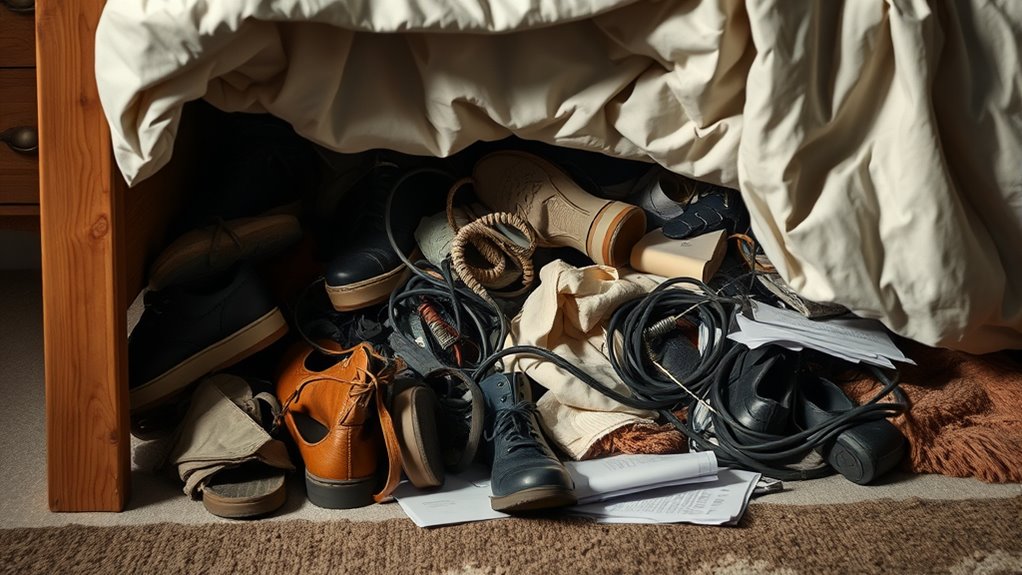
Visual clutter in your sleeping environment can considerably affect your mental state, making it harder to relax and unwind. When your under-bed storage is filled with unnecessary items or clutter, your mind perceives it as chaos, increasing stress and anxiety levels. This mental distraction can interfere with your ability to settle into a restful sleep, leading to frequent waking or difficulty falling asleep. Clutter also creates a sense of overwhelm, making your space feel less peaceful and more draining. Over time, this constant visual stimulation can contribute to feelings of being overwhelmed or even helpless about maintaining a tidy environment. Clearing clutter from beneath your bed helps create a calmer, more organized space that promotes relaxation, making it easier for your mind to switch off and prepare for restorative sleep.
Pest Attraction: Unwanted Guests Beneath Your Bed

Clutter beneath your bed doesn’t just clutter your mind—it can also invite unwanted pests into your sleeping space. Piles of clothes, old papers, or forgotten snacks create perfect hiding spots for dust mites, spiders, ants, and even rodents. These pests are attracted to the warmth, darkness, and crumbs that often accumulate in cluttered spaces. Once they settle beneath your bed, they can easily come into contact with you, increasing the risk of bites, allergies, or infections. Additionally, their presence can disturb your sleep, leaving you restless and anxious. Keeping the area tidy and removing unnecessary items not only reduces clutter but also discourages pests from taking up residence beneath your bed. Prevention is key to maintaining a healthy, pest-free sleep environment.
How Storage Materials Can Harm Indoor Air Quality
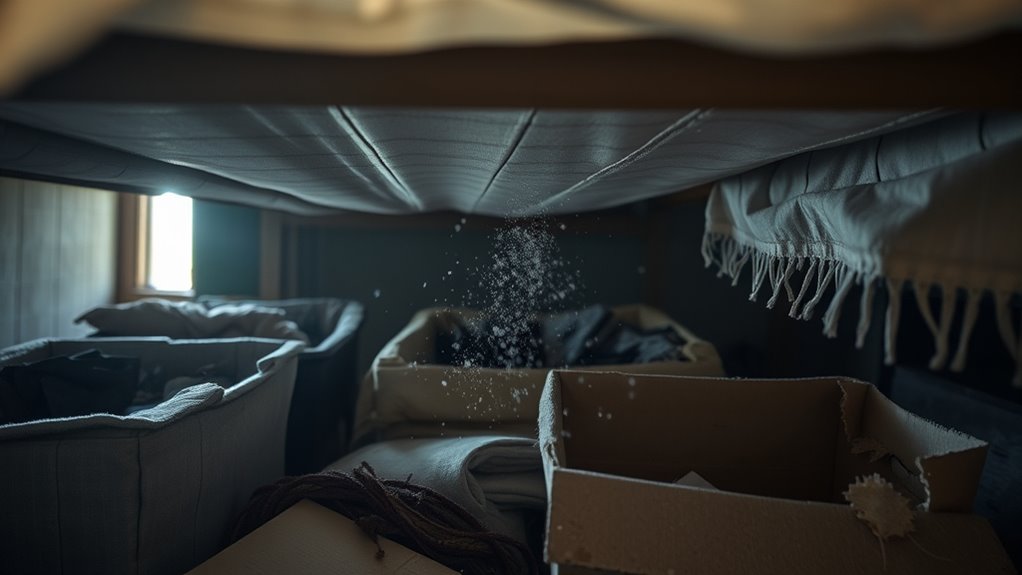
Many storage materials used beneath your bed can release volatile organic compounds (VOCs) and other pollutants into the air you breathe. These chemicals can cause headaches, dizziness, or respiratory issues over time. Particleboard, plastic bins, and certain fabrics often emit fumes that silently degrade your indoor air quality. You may not notice the subtle buildup of toxins until symptoms worsen.
| Material | Potential Harm |
|---|---|
| Particleboard | Emits formaldehyde, causing irritation |
| Plastic bins | Release VOCs, affecting breathing |
| Synthetic fabrics | Off-gas chemicals, lingering in air |
| Cardboard boxes | Mold and dust accumulation |
Protect your sleep by choosing storage options that don’t compromise your air quality.
The Effect of Clutter on Stress and Anxiety Levels
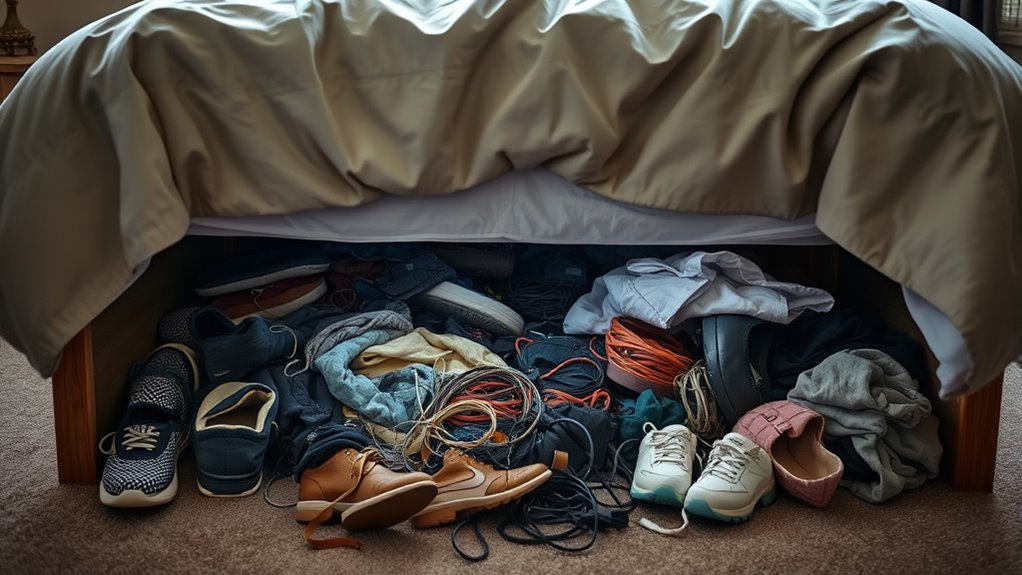
Clutter can raise your cortisol levels, making you feel more stressed throughout the day. When your space is chaotic, your sleep patterns often get disrupted, leaving you tired and restless. Clearing clutter not only eases your mind but also promotes better sleep and lower anxiety.
Clutter Elevates Cortisol
When your space is cluttered, your stress levels tend to rise without you even realizing it. This increase in stress spikes your cortisol, the hormone linked to anxiety and fatigue. The more cluttered your environment, the harder your mind works to process the chaos, leading to higher cortisol production. Over time, this elevated cortisol can interfere with your sleep, making it harder to unwind and rest properly. Clutter signals your brain that there’s unfinished business, triggering a stress response. To visualize this:
| Clutter Effect | Result |
|---|---|
| Visual chaos | Increased mental workload |
| Unfinished tasks | Elevated stress hormones |
| Disorganization | Anxiety and restlessness |
| Overstimulation | Higher cortisol levels |
| Sleep disruption | Poor sleep quality |
Disrupted Sleep Patterns
Elevated stress and anxiety levels caused by a cluttered environment can substantially disrupt your sleep patterns. When your space is chaotic, your mind struggles to unwind, making it harder to fall asleep or stay asleep through the night. Clutter acts as a constant visual reminder of unfinished tasks or unresolved worries, increasing mental alertness when you should be relaxing. This heightened state of arousal interferes with your body’s natural sleep cycle, leading to restless nights and poorer sleep quality. Over time, disrupted sleep can worsen mood, reduce focus, and weaken your immune system. Clearing your space and creating a calm, organized environment helps signal to your brain that it’s time to rest, promoting a more restful and uninterrupted sleep.
Tips for Creating a Clean and Calm Sleep Space
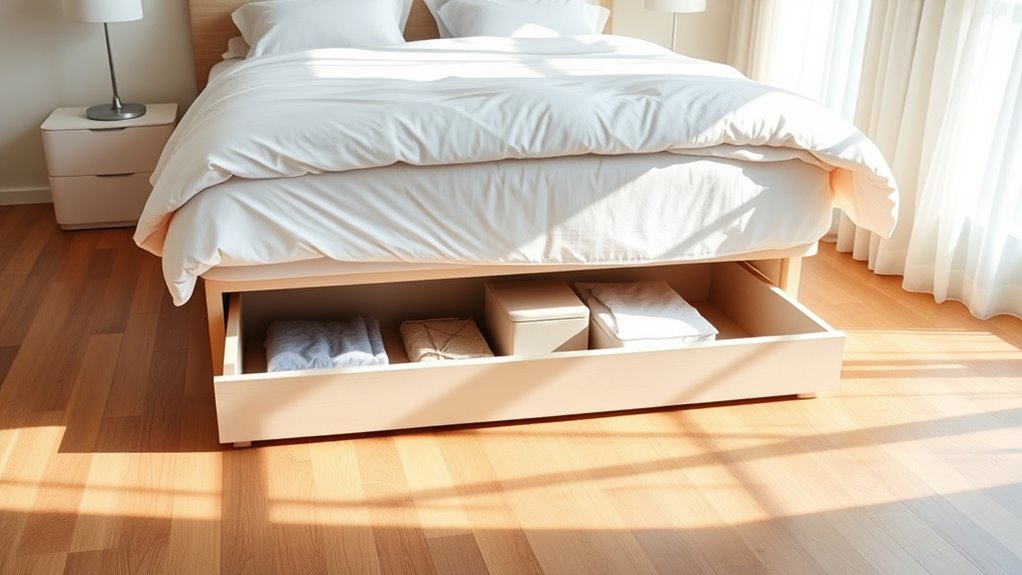
Creating a calm and tidy sleep space starts with organizing your belongings and minimizing distractions. When your bedroom feels cluttered, it’s harder to relax and unwind. Focus on clearing surfaces and removing unnecessary items. Keep only essentials nearby, like a lamp, alarm clock, or a book. Use calming colors and soft lighting to promote relaxation. Freshen up the space regularly to keep it feeling inviting. Consider adding soothing elements like gentle artwork or plants to create a peaceful atmosphere. Remember, a clutter-free environment signals your brain that it’s time to rest. By maintaining a clean and calm bedroom, you’ll establish a sleep-friendly routine and improve your overall sleep quality.
- Store items out of sight, like under the bed or in drawers
- Limit electronics and turn them off before bed
- Incorporate calming decor and soft lighting
Alternatives to Under-Bed Storage for a Peaceful Bedroom
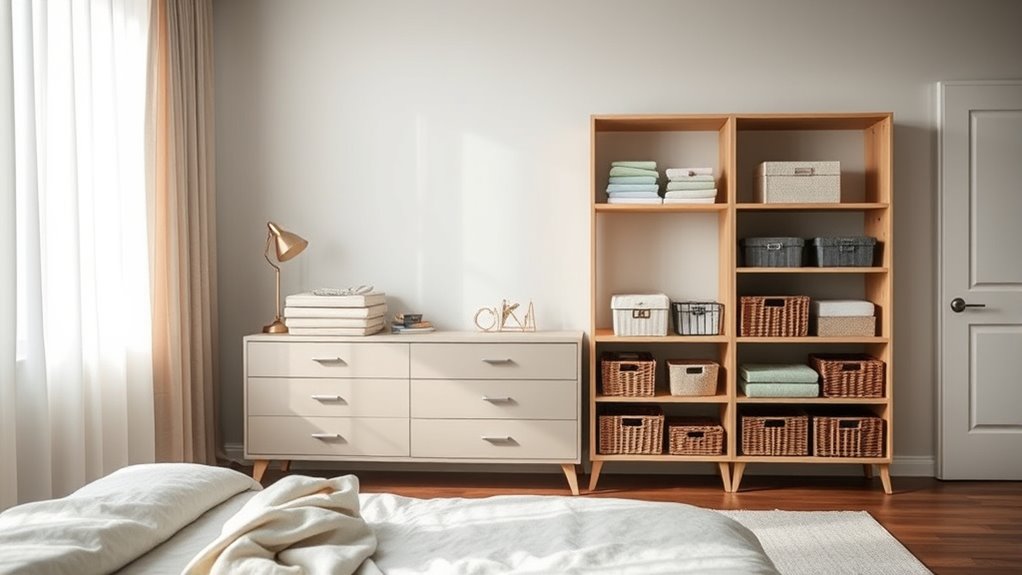
If under-bed storage doesn’t suit your space or preferences, there are plenty of alternative solutions to keep your bedroom tidy and peaceful. Consider adding a tall, slim wardrobe or shelving units to maximize vertical space without cluttering the floor. Baskets and bins placed on shelves can store seasonal clothing or linens neatly out of sight. Under-the-dresser drawers or ottomans with hidden compartments also offer discreet storage options. Wall-mounted hooks or pegboards can organize accessories, reducing visual clutter. Using multi-functional furniture, like beds with built-in drawers or storage headboards, helps maintain a clean look. These alternatives keep your belongings accessible while preserving a serene, clutter-free environment, promoting better sleep and a more relaxing bedroom atmosphere.
Frequently Asked Questions
How Often Should I Clean Under My Bed to Prevent Health Issues?
You should clean under your bed at least once a month to prevent dust, dirt, and allergens from accumulating. Regular cleaning helps reduce the risk of respiratory issues and keeps pests away. Use a vacuum or damp cloth to remove debris and consider decluttering to maintain a healthy sleeping environment. Consistent cleaning not only improves hygiene but also promotes better sleep quality by minimizing potential irritants.
Are There Safe, Non-Toxic Storage Options for Beneath the Bed?
Think of your under-bed space as a hidden garden; you want it safe and inviting. You can find non-toxic storage options like bamboo baskets, cotton bins, or silicone containers. These materials are free from harmful chemicals, keeping your space healthy. Regularly clean and ventilate your storage to prevent dust buildup. Choosing eco-friendly, non-toxic options creates a safe haven beneath your bed, promoting better sleep and peace of mind.
Can Under-Bed Storage Affect the Longevity of My Mattress?
You might wonder if under-bed storage can impact your mattress’s lifespan. If you store heavy or bulky items directly on your mattress or if moisture gets trapped beneath, it can cause sagging, mold, or deterioration over time. To protect your mattress, guarantee good ventilation, use lightweight, breathable containers, and avoid placing excessive weight directly on the mattress. Proper storage habits can help extend its longevity.
What Are the Best Ways to Organize Under-Bed Spaces for Minimal Clutter?
Think of your under-bed space as a garden needing careful tending. To keep it tidy, use clear bins for easy visibility, label everything, and create zones for different items. Regularly declutter, removing things you no longer need. A well-organized under-bed area not only minimizes clutter but also makes finding things quick and stress-free—like harvesting ripe vegetables instead of searching through weeds. Keep it simple, and your space stays neat and functional.
How Does Under-Bed Storage Impact Overall Bedroom Airflow and Ventilation?
When you use under-bed storage, it can impact your bedroom’s airflow and ventilation. If you pack the space too tightly or use airtight containers, airflow decreases, trapping dust and moisture. This can lead to poor air quality and musty odors. To keep ventilation ideal, leave some space around stored items, use breathable containers, and open windows regularly. Proper organization helps maintain fresh air and a healthier sleeping environment.
Conclusion
Sometimes, the clutter under your bed isn’t just about messy shelves—it’s quietly affecting your sleep. You might notice better rest just by clearing that space, especially when you realize how dust, mold, and stress can hide there. Coincidentally, as you tidy up, you create a calmer environment that invites relaxation. Small change, big impact—your peaceful sleep might just start beneath the surface, where the hidden clutter was quietly sabotaging your nights.
